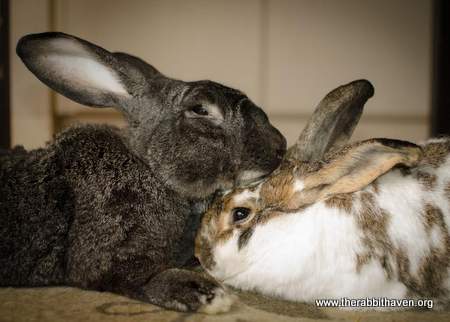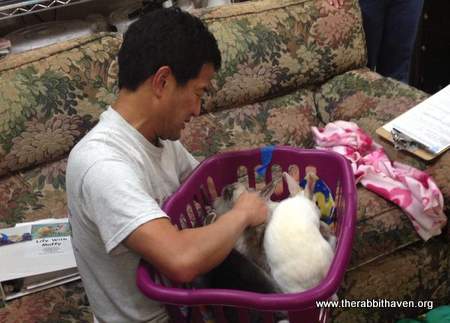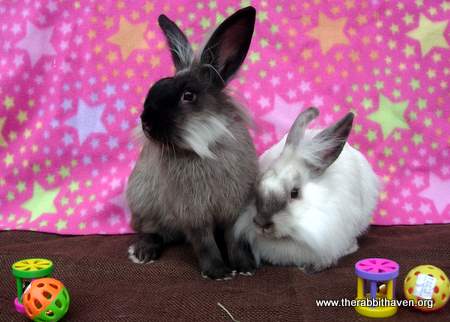 Before attempting any introduction, the rabbits should be spayed or neutered. You should wait at least a month after spay or neuter before attempting a bonding session, as it gives them time to heal and for their hormones to settle. *unless you are willing to separate the two totally until 4 week post spay/nueter.
Before attempting any introduction, the rabbits should be spayed or neutered. You should wait at least a month after spay or neuter before attempting a bonding session, as it gives them time to heal and for their hormones to settle. *unless you are willing to separate the two totally until 4 week post spay/nueter.
Rabbits are highly social creatures and there is nothing sweeter than seeing a cuddling pair of rabbits grooming each other. They are clearly relaxed and happy and benefit from living in pairs or groups. However, despite their love of companionship, you can't just put two together and expect them to get along. Male/female bonds tend to work best, but same-sex bonding can work. Size, age and breed are not important factors in choosing a mate, as all combinations can work. You are more likely to have a successful bond if both are adults.
 Choosing a mate with your rabbit
Choosing a mate with your rabbit
If you already have a rabbit, arrange for him/her to meet a few rabbit(s) you have identified as good potential companions. You want to have help to determine if they get along, and then have assistance to guide you through the bonding process. If you already have a pair living separately, you can also try to bond the trio.
Basics to know
Rabbits rarely fall in love at first sight, but indifference is a good first sign of a potential pairing. Some rabbits will groom, other rabbits will present their heads to be groomed. Some rabbits lean into the other rabbit which is a very good sign. After an initial meeting you may notice the interest level come up and also notice that the rabbits may begin to move about the room where they are together exploring each other a bit, eating hay, and carrying out self grooming. Sometimes one of the bunnies just lays down and relaxes. This can be a sign of acceptance in a rabbit pair. Sometimes (not often) grooming begins to occur between the two rabbits - this is also a good sign to see.
Our bonding session takes about one hour with breaks at our bonding centers. The rest of bonding work is carried out by you at home. You are provided with plenty of helpful tips for continuing this bonding and hopefully your rabbits will become a bonded pair soon. Following the instructions we offer here you can continue a bonding once you are home safely, and with good results. Bonding can take two weeks while a more difficult bond can take months. It takes patience and commitment and it's easy to get discouraged.
 The process
The process
Allow both rabbits time to rest, use the litter box and feel safe and secure in a pen or carrier prior to introduction. The bunny parent is present along with our bonding staff member. We begin by holding both rabbits together against our chest. The rabbits show us quickly what their personalities are- Watch for rates of respiration, any agitation, signs of interest and of course sign of any aggression (nipping, etc.) Actual face to face bonding: It is best to do bonding sessions in a neutral room with no furniture to hide under. WE use an x pen with a solid sheet as the flooring. We have one litter box large enough for two, plus fresh water and a big hay basket. The bonding assistant sits on the floor with the rabbits. After holding and learning more about the rabbit we place both rabbit on the floor of the matchmaking room together and begin Cross petting the rabbits. Cross petting helps the rabbits relax and also allow the scents of each rabbit to be mixed helping rabbits to accept the other more easily.
Bonding work takes place in a neutral room with no other rabbits except the two begin bonded. Your bonding assistant and one parent are present. While bonding you should be prepared to quickly get in-between any fight to stop it cold before it starts. Watch body language. Dominance, often displayed as mounting (humping) is perfectly normal, but is only okay IF the hump-ee doesn't mind and if it's not head humping (extremely dangerous for males if they get their penis bitten). If you see any signs of aggression like ears back at a 45 degree angle, tails raised, tension, circling, or chasing - separate the buns. Be careful to understand the difference between dominance and aggression. You can gently push the dominant bun to the side. Note: Regarding humping or mounting: Both males and females can mount it is a dominance behavior.
Slight behavior modification
Another process the Haven uses is to place the bunny being humped across the other rabbit, just for a moment. Then release and cross pet more while both rabbits have their feet on the ground. We never use spay bottles of water or any aggressive action to bond rabbits. We may use our voice to indicate stop or to indicate praise. Once the rabbits are comfortable with each other we allow a more free range on of play and sometimes we include a cart ride as space allows. Cart rides can be carried out as s follows: At your local pet store find a cart with deep area for purchases. Place a carrier pad in the bottom and the rabbits on top side by side facing forward then slowing move the caret around the aisles of the store. The rabbit find this interesting and is an activity they share. Often they move closer together during a cart ride creating another type of bond. Cross petting is done as well during cart rides. Our cart rides last about 15 minutes /. During which time we stop on occasion to face the rabbits forward, and to cross pet. This is just another method used to help rabbits bond. Bonding takes commitment and patience on your part.
 Once home in a neutral territory, carry out continuing bonding play for 10 minutes at a time, two times daily for one week. Provide plenty of attention to both rabbits. Allow rabbits to see one another. Feed at the same time. If all goes well for a week you may increase their time together even allow them time to play in supervised areas. Have patience. The hardest thing about bonding is human patience (or lack thereof). Remember not to rush your rabbits. The object is to build up many, many peaceful SHORT sessions rather than to push too fast for longer sessions. We often hear "Well they did so well after 5 minutes that I extended it to 15 minutes. Then the fight broke out!" - a common mistake.
Once home in a neutral territory, carry out continuing bonding play for 10 minutes at a time, two times daily for one week. Provide plenty of attention to both rabbits. Allow rabbits to see one another. Feed at the same time. If all goes well for a week you may increase their time together even allow them time to play in supervised areas. Have patience. The hardest thing about bonding is human patience (or lack thereof). Remember not to rush your rabbits. The object is to build up many, many peaceful SHORT sessions rather than to push too fast for longer sessions. We often hear "Well they did so well after 5 minutes that I extended it to 15 minutes. Then the fight broke out!" - a common mistake.
When your rabbits show positive signs of progress, you can gradually increase the time they spend together in the neutral area. After they can spend hours together, which can take weeks of gradually longer sessions, you should be looking for signs of affection, as in grooming and cuddling. With a tentative friendship, they should always be separated when you're not around. After you have completed holding, face to face bonding, and floor bonding together with your rabbits, and it is time for them to come home, you may use the side by side housing methods to continue bonding.
 Set up side by side housing
Set up side by side housing
Rabbits are housed in side-by-side cages. This is our preferred bonding set up system for families that are bonding their rabbits at home. They should not be able to touch noses through the cages before they are safely bonded. Fights can break out, seemingly out of nowhere, and damage (both physical and emotional) can occur if they bite each other's noses. The physical wounds could potentially abscess, and the grudges or resentments at being bitten could set your bonding efforts back. Keep bunnies living caged, side-by-side with three inches of space between the cage bars - no touching, and don't let one bun exercise in the same room where the other is confined to prevent resentment forming. Switch their soiled litter boxes if you like, to increase their getting used to each others' scents. Sometimes we suggest actually exchanging rabbits in pens -this works well too.
Once your rabbits are bonded they will live in one very large enclosure or may be free roam. With your patience and cooperative, compatible bunnies, you can eventually enjoy the sight of your bunnies together, and they can enjoy each other's company. Two rabbits really can be as easy as one. Boredom and depression are common symptoms of loneliness in rabbits, and boredom can sometimes lead to destructiveness.
Matchmaking and bonding takes time but in the end it is worth it to see that your rabbits have a companion of their own kind. Companionship and social interaction is very important to rabbits. Enjoy your new bonded pair of rabbits!
